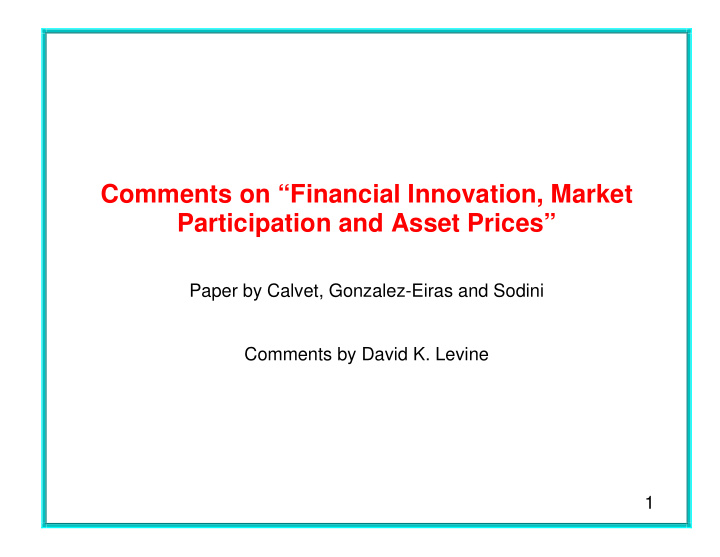



Comments on “Financial Innovation, Market Participation and Asset Prices” Paper by Calvet, Gonzalez-Eiras and Sodini Comments by David K. Levine 1
EMPIRICAL PUZZLE Why did has the equity premium fallen? Has it? This surprised me, so I looked at one of the references by a reliable researcher – Cochran [1997] “Where is the market going…” • Cochran: (from abstract) "...average [rate of return on equity] is poorly measured." • (from introduction) "As I write the Dow has just broken 8000" • (from the conclusion) "I think the wise observor shades down his estimates of the future equity premium even more than suggested by the statistical documented above." • the thrust of the paper is that the equity premium is likely to diminish in the future because prices are so high...Not that the equity premium has already diminished. 2
Remark: the equity premium may have gone down because of increased volatility Smaller puzzle: "the consumption of stockholders tends to be more correlated with the market than the consumption of non-stockholders..." [Mankiw and Zeldes] is this surprising? are there models in which this isn’t true... 3
THEORY technical aside: disconnect between the set of agents for which existence is asserted in the text and in the appendix claim: new financial instruments allow significantly greater diversification of risk, lead to increased market participation and so lower the risk premium for preexisting instruments claim: riskless rate R generally increases with financial innovation generally known that riskless rate increases with any lowering of asset market frictions -- lenders are seldom constrained... dual effect of completing markets -- increases benefit of being in market, but also raises interest rates (but this should only discourage participation by borrowers??) 4
STORY Account given relies on significant financial innovation of non- redundant securities big falls in equity premium largely due to large drops in stock prices: is big decline in Japanese stock market somehow due to financial innovation in Japan? If these new financial instruments are so useful, why were they introduced so late in the game? 5
One might argue the opposite: costs of participation relative to wealth have decreased, not remained constant • absolute costs have declined – the financial securities market is heavily regulated, and brokerage costs have been substantially reduced by deregulation • wealth has increased One implication (Helios Herrara) increased volatility; this would be an interesting addition to the paper 6
So we would expect more participation; moreover entry by inexperienced investors, a situation ripe for fraud (either intentional or accidental) • savings and loans • Long Term Capital Management • Enron New securities seem to have been used to trick naïve investors and foil regulators 7
One could argue that “foiling regulators” is in fact a method of introducing non-redundant securites Have “new” instruments really been used to diversify risk as the theory says they should? Instruments seem to involve more reallocation of risk among firms, rather than among stock holders...Why are firms reallocating risk for stockholder? My own best guess: mortgage backed securities might fill the role suggested in the theory Derivatives would seem to be redundant 8
CALIBRATION PROBLEMS WITH THE TWO-PERIOD MODEL • Interpretation as steady state of multi-period • income distribution changes make calculations a mess • seems plausible but with incomplete markets multi-period much different than two period: borrowing and lending allow self-insurance theorem: with bonds and sufficient patience, get to first best so effect of reducing market incompleteness diminished in importance 9
CALIBRATION Mean income normalized to one Kreps-Porteus preferences with constant absolute risk aversion coefficient of absolute risk aversion translates to relative risk aversion ; corresponding intertemporal coefficient is �� ��� � � � � absolute risk aversion is calibrated to income, not wealth; it does make a difference; relative to wealth coefficient of relative risk aversion should be about 20. 10
� � � �� � � � � � � � � � � � � � � � � � � � � standard normal “aggregate shocks” � � � � � are independent � � � � � � � � � � � � � � � ���� � � � � � ���� � ����� ����� �� � � � � � � � � � � � ��� ���� ���� ������ � � � � � � � � � � � � � � ��� ���� � � � � � � calibrated to gini coefficient of 0.4 11
discount factor 0.96 0.8% of income is cost of being in the market (I looked on the internet: saw $16 per trade advertised...) alpha is the index of “market completeness” ; the first factor is interpreted as labor income, this is intended ��� � � � to capture the correlation between aggregate labor income and the stock market second factor has � moving from 0 to 1 � moves equity premium from 7% to 4.5% what on earth is � supposed to capture? � 12
Recommend
More recommend